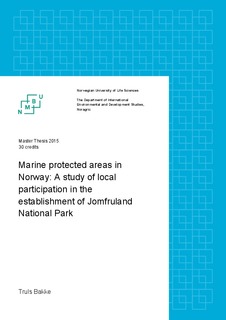| dc.description.abstract | Bound by the International Convention on Biological Diversity (1992), Norway aims to protect 10 percent of its coastal areas. This ambition imply establishing protected areas in densely populated regions along the coastline. In accordance with a more participatory management model defined by the New Biodiversity Act (2009), Norway seeks to include local stakeholders into protected area management. This is a new practice and it is important to study how the state is able to include local perspectives and interests into the conservation processes. This thesis looks at how actors and structures interact and influence the emergence of Jomfruland National Park by qualitatively observing participatory arrangements and interviewing participants from start-up to the creation of the draft plan. This thesis aims at explaining how the organisational structure leads towards a partial participatory arrangement and management regime. It builds on an integral theoretical framework and consider both resources, individual worldviews, collective discourses, rights and capabilities of actors as well as rules or regulations.
Local, regional and national actors proved to have different preferences regarding the meaning and concept of a national park. They initiated and mobilized separate political processes in order to shape the national park. The organisational structure of the process gave rights and responsibilities to different actors with different preferences. In doing so, the organisational structure influenced the outcome. In accordance with the New Biodiversity Act, the municipality received the responsibility to establish Jomfruland National Park. The local community on Jomfruland and Stråholmen proved to be well organised and able to mobilize a significant political force against decisions that they opposed. These tendencies led the process towards a less restrictive national park regime than those previously postulated by the Environmental Authority.
The findings show that, in spite of confrontations, the local participants, the municipality and the county governor agreed on both prescripts and management guidelines. However, their notion of a national park proved less restrictive to that of the Environmental Authority. In February 2015, the Environmental Authority refused to accept the draft plan. The local community allied with the municipality and went against the conservation initiative.
While the establishment process managed to include local stakeholders, it failed to give them power to shape decisions. The national park was a central initiative, not a local one. This created tension from the very beginning. In this way, participation became more as a means to an end, rather than an end in itself. This thesis argues that the process could have reduced tension by including local stakeholders from the beginning and by collaborating towards common goals in respond to common challenges. | nb_NO |

